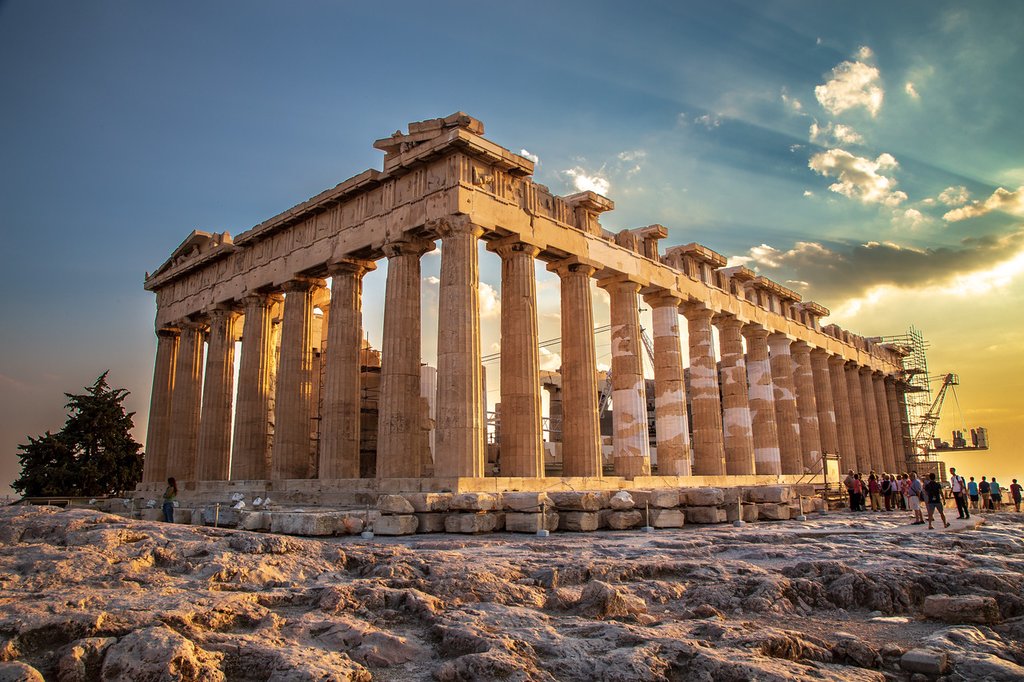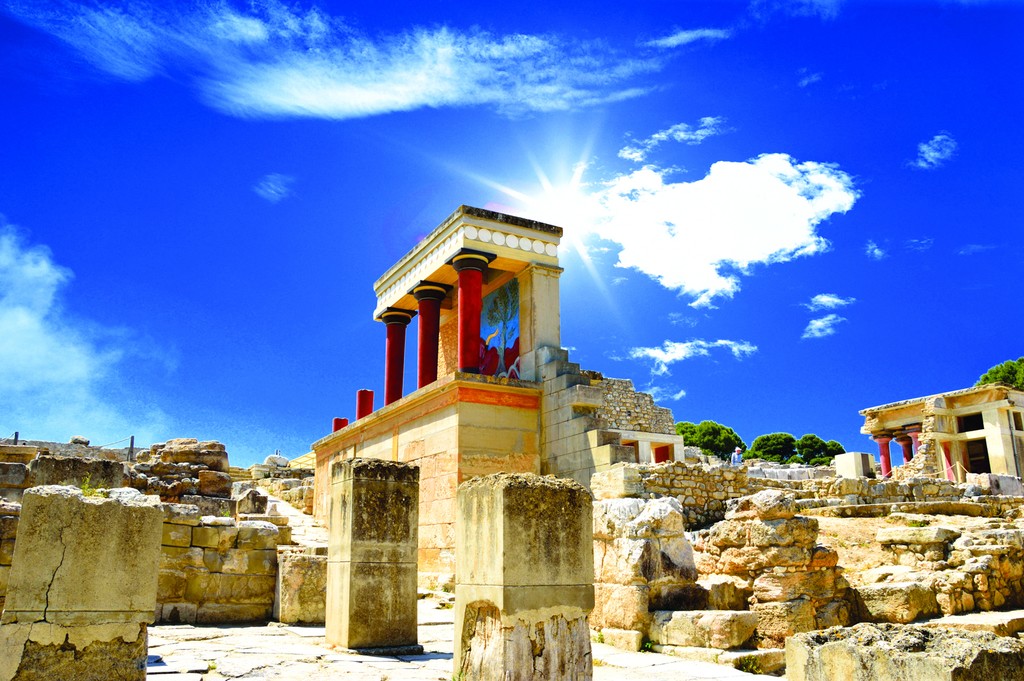Highlights
- Hear ancient myths about the Acropolis and Parthenon
- Exercise like an Olympian at the Panathenaic Stadium
- Visit Elafonissi, one of Crete's most popular beaches
- Excavate Minoan reproductions with an archaeologist
Brief Itinerary
| Day | Highlights | Overnight |
|---|---|---|
| Day 1 | Arrive in Athens & Explore the Plaka Neighborhood | Athens |
| Day 2 | Painting the Parthenon & Family Mythology Tour | Athens |
| Day 3 | Olympic Games Workout & Athenian Riviera Tour for Families | Athens |
| Day 4 | Athens to Rethymno | Rethymno |
| Day 5 | Minoan Myths Around Knossos | Rethymno |
| Day 6 | Chania Beach Day & Excavation Experience | Rethymno |
| Day 7 | Rethymno to Athens & Depart |
Detailed Itinerary
Day 1: Arrive in Athens & Explore the Plaka Neighborhood

Welcome to Greece! Once you've settled in at your lodgings, head out into Athens for a walk through the Plaka neighborhood, the oldest and the most charming neighborhood of the city and ideal for an evening stroll.
Walk in the pedestrian part of the city and try to trace the remnants of the city’s various stages at spots like the Roman Agora, the Old University, the Tower & the Bath House of the Winds, the Benizelos Mansion, the Monument of Lysicrates, and all the lovely Byzantine churches. If you have the time, stop in at one of the two children’s museums, the Museum of Greek Children’s Art and the School Life & Education Museum.
Settle in at a taverna for dinner or pick up souvlaki along Monastiraki Square, then finish it off with some loukomades, traditional fried dough with honey and cinnamon.
Day 2: Painting the Parthenon & Family Mythology Tour

Practice your artistic skills while learning about ancient Athens by painting the Parthenon, the symbol of ancient Greece. A family-friendly and local professional painter will take you to Pnyx Hill, a scenic spot with a clear view of this world-renowned monument.
Before painting, you'll learn about the site's history. Ancient Greeks built the Parthenon between 447-432 BCE as a dedication to the goddess Athena, the protector of Athens. A feat of Greek architecture, the marble temple contains no straight lines or angles anywhere among its 46 outer and 19 inner tapered Doric columns.
To sharpen your skills, you'll enjoy a short workshop on drawing and painting techniques. Learn about color combinations, perspective, and capturing the unique architectural components of the Parthenon.
Now that your creative juices are flowing, explore the Acropolis and Ancient Agora with your family, learning about Greek mythology and history while enjoying views of the city and kid-friendly activities.
After meeting your guide, you'll start your walk up to Acropolis Hill, the "Sacred Rock" that defines Athens. You'll visit all its popular monuments, including the Parthenon, Theater of Dionysus, Temple of Athena Nike, and Temple of Erechtheion. Listen to the legends of the Greek pantheon, such as the mighty Zeus, Athena (goddess of wisdom), Poseidon (god of the sea), Dionysus (god of wine and theater), and more. The stories will keep kids entertained and asking questions.
After enjoying Acropolis Hill and learning the city's secrets, you'll walk down to the ancient marketplace, the Agora. Socrates and Plato hosted many political and philosophical discussions on this plaza. At the end of the tour, enjoy a family activity inside the ancient Agora, using all your newfound knowledge about Greek gods, goddesses, and heroes.
Day 3: Olympic Games Workout & Athenian Riviera Tour for Families

Get your blood pumping and try your luck as an Olympian at the very venue where the first modern Olympics took place in 1896. You’ll start your day at the Zappeion, a neoclassical building set just below the National Garden. Here, you’ll meet your trainer and learn how the ancient Olympics impacted society for over a millennium.
The year 1896 marked the revival of the ancient Olympic Games, which occurred every four years starting in 776 BCE. You’ll stand in the very spot where the athletes stood and learn how they trained, what the games entailed, and how the competition evolved.
After learning about the games, you'll start your workout in a historic gym. Your trainer will teach you some classic techniques from the original Olympic events, including the discus and the javelin throw. You'll also practice more modern sports, such as the shot put, long jump, and relay race.
All of your training will prepare you for your own competition—a race in the Panathenaic Stadium! This stadium is the only one in the world made entirely of marble. Following the hallowed track, you'll race around the arena before receiving your official certificate of participation.
Next up, a private car will whisk you along the Athenian Riviera, a beautiful coastline with hidden bays and beaches. You will pass from the Stavros Niarchos Cultural Center and Park and then by the Flisvos Marina with its family-friendly restaurants and coffee shops.
You can make an optional stop here to visit the Neraida Floating Museum, which narrates the business career of the ship’s owner, John Latsis, as well as the history of the ship from its construction in 1939 to the completion of its reconstruction in 2010. If you and your kids love ships and boats, and especially battleships, do not miss the opportunity to visit the Park of Naval Tradition inside the marina. Historic vessels are docked there, such as the destroyer “Velos” (now a museum of the struggle against the military dictatorship), the only copy of an ancient trireme named “Olympias” and the cable-laying ship “Thales of Miletus" constructed in the U.S. in 1909.
Further south, another optional stop is at the rescue and rehabilitation center for sea turtles, run by the Sea Turtle Protection Society of Greece in Glyfada. Its purpose is to treat injured and sick sea turtles and eventually release them back into the sea, as well as to raise awareness regarding this rare species that reproduces in the sandy beaches of the Mediterranean Sea. Take part in the sea turtle rescue tours, adopt a sea turtle for 10 days, and enjoy a meal on the Glyfada beach.
The tour ends at the tip of Cape Sounion, home to the famous Temple of Poseidon that overlooks the Saronic Gulf and its islands. Before heading back to the city, you can opt for an early dinner at a traditional taverna right on the beach. Enjoy fresh seafood caught just a few feet from where you're sitting, plus good company and the sound of the waves lapping the shore as you watch the sunset.
Day 4: Athens to Rethymno

Chat with a local specialist who can help organize your trip.
The first thing to notice is how the city's Venetian fortifications mingle harmoniously with contrasting religious structures. You'll find Orthodox and Catholic churches standing near mosques and mansions sporting Venetian architecture, all blending together. In the small Venetian harbor, admire the 13th-century Venetian mole that once protected the city from the wild Cretan Sea. At the end stands the imposing lighthouse, built by the Turks after the 17th century.
Next, walk up to the Venetian Fortezza, an impressive Venetian fortress built in 1573 CE to protect the city. Here you'll find the remains of buildings and churches, plus incredible views of the city and the sea. Move on to the Archaeological Museum and enjoy exhibits from Neolithic to Roman times. You can also view Archaic and early Christian artifacts from Eleftherna or Minoan items from the Armeni and Monastiraki sites.
For something a bit lighter, pop into the Folklore and History Museum. Housed in a restored Venetian building with a beautiful courtyard, the gallery offers eight halls with over 5,000 items dating from the 17th to the 20th centuries. Peruse collections of textiles, woven baskets, embroidery, lace, historical costumes, ceramics, photographs, maps, weapons, coins, and more.
Stop to browse artisan shops or grab a snack at one of the seaside cafes as you embrace the city's leisurely pace.
Day 5: Minoan Myths Around Knossos

Discover the ancient scenery and myths of Minos, Ariadne, Theseus, the Minotaur, and the Labyrinth on this family-friendly adventure. This unique educational activity explores the roots of the Minoan civilization with some of the most popular Greek stories and myths and will prepare your family for an optional visit to the archaeological site at the Palace of Knossos.
The day's activities were inspired by the great writer and philosopher Nikos Kazantzakis. His book, "At the Palaces of Knossos," dives into the ancient Minoan civilization. With the help of interactive games and activities designed by experienced educators, your family will travel back in time 4,000 years to one of the most interesting periods of time: Minoan Crete.
You'll enjoy a picnic lunch similar to the traditional Minoan diet. If you so choose, you can also add on a visit to the Palace of Knossos archaeological site itself, where an experienced interpretive guide will help you explore the archeological site and put your new knowledge to the test.
Day 6: Chania Beach Day & Excavation Experience

Elafonissi and Falassarna are perhaps the most famous beaches on Crete, with the shallow waters of Elafonissi Beach perfect for swimming and walking out to a neighboring island. The clear, turquoise waters combine with white-and-coral-hued sand to create a unique landscape of unmatched beauty. A bit closer to Chania is a close second, Falassarna Beach, which offers the same long stretch of soft, sandy coastline with shallow water and pink hues. Both are excellent for snorkeling.
You can also visit the Balos Lagoon to enjoy a rare combination of pink-tinted sand and a Venetian fortress standing atop a rocky islet. You get both history and incredible scenery, plus fluffy sand and clear, shallow waters as well as a few hiking trails nearby and some basic amenities.
Once you've soaked up sufficient sun, join a real archaeologist on an excavation simulation for kids. This activity allows you to find Minoan artifacts and learn about daily life in prehistoric times.
During the excavation experience, your family will receive an introduction to archaeology: what is it, what do archaeologists do, and how do they tackle an excavation? Then, you'll conduct an excavation in a pit of replicated Minoan artifacts to reconstruct history with the help of a professional archaeologist.
Afterward, enjoy a lunch of traditional Minoan cuisine. Learn about how people used to heat their food in clay cookware over an open fire pit before you dine on a modern version of ancient Cretan cuisine.
Day 7: Rethymno to Athens & Depart

Head back to Athens to catch your international transfer and wave goodbye to Greece as you head home or onto your next adventure.


